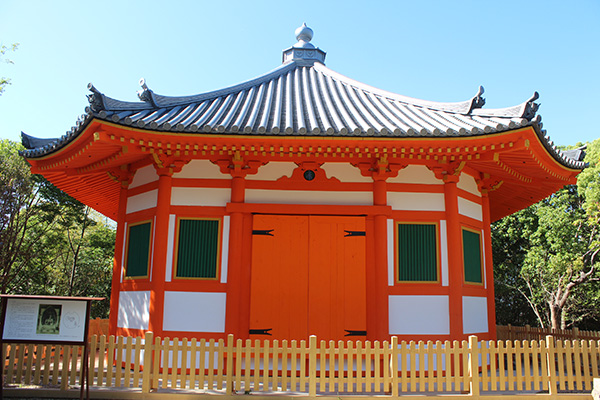Hakkakudo (Octagonal Hall)

Hakkakudo is the only remaining hall of the important Buddhist structures that used
to be part of Iwashimizu Hachimangu, historically a shrine-temple complex that practiced a syncretic
fusion of Shinto and Buddhism. Hakkakudo housed a three-meter-tall wooden statue of Amida, a Buddha
strongly connected to the deity Hachiman still worshipped at the main hall of Iwashimizu Hachimangu.
The architectural style of this eight-sided vermilion hall is rather rare: it is not a regular
octagon, so its sides are not all of equal length. The shape of the structure can be described as a
square with the corners cut off. Though Hakkakudo was originally built in the thirteenth century, its
current form dates back to the seventeenth century. The hall was rebuilt and repaired several times
with donations from high-ranking nobility and powerful lords. This financial support reflects the
strength of belief in Amida Buddha and Hachiman that was widespread at that time.
In 1868, the Meiji government ordered the separation of Shinto and Buddhism, and all Buddhist
structures and objects of worship had to be removed from Iwashimizu Hachimangu. To save Hakkakudo, a
former chief abbot of the nearby Shoboji Temple had it moved to its present location atop an ancient
burial mound in 1870.
The statue of Amida was displayed at the Kyoto National Museum from 1998 and transferred to Shoboji in
2008. It does not have the creator’s signature; however, based on the style researchers suggest that
it could be the work of Kaikei, a renowned sculptor of the Kamakura period (1185–1333). The statue is
now a nationally designated Important Cultural Property.
In 2012, the past and present locations of Hakkakudo were designated National Historic Sites as part
of the Iwashimizu Hachimangu precincts. The hall itself underwent a large-scale restoration that was
completed in 2019. Based on extensive analysis, the interior and exterior of the hall were repainted
in bright colors to reflect the way it looked centuries ago.
The interior of Hakkakudo is usually closed to the public, but it is open several times a year on
special occasions.

